Key takeaways:
- Pro-life advocacy emphasizes compassion and community support, aiming to empower women beyond their pregnancy choices.
- Inclusivity in campaigns requires recognizing diverse experiences, fostering open dialogue, and ensuring all voices are heard to enrich the discourse.
- Collaborative partnerships enhance outreach by combining resources and building trust among various organizations and communities.
- Measuring the impact of inclusivity involves both quantitative data and qualitative insights to understand community engagement and representation.
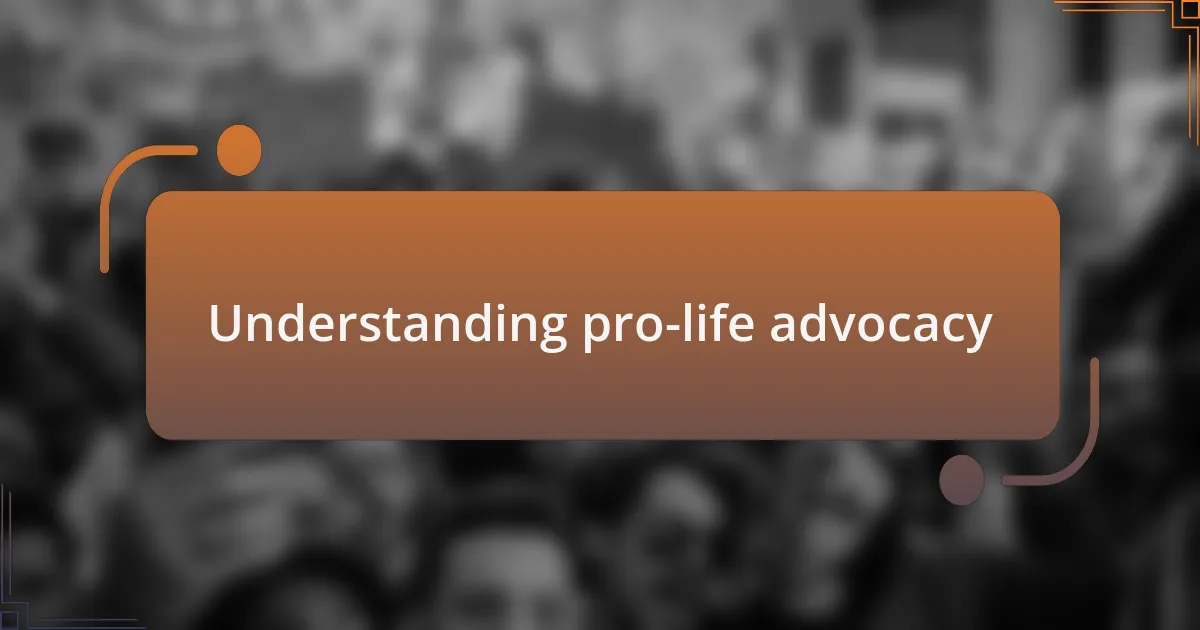
Understanding pro-life advocacy
Pro-life advocacy is fundamentally about valuing every human life, emphasizing that even the most vulnerable deserve protection and care. I vividly remember my first encounter with a woman who had faced an unplanned pregnancy. She shared her struggle and how her decision to choose life transformed not just her life but also the lives of those around her, sparking a sense of hope in me. How often do we overlook the stories behind statistics, reducing complex situations to black-and-white decisions?
The heart of pro-life advocacy lies in compassion, empathy, and support for women in challenging situations. I recall organizing a community event where we brought together local support services and shared resources for expectant mothers. Watching the connections being made felt transformative. It truly made me realize that advocacy isn’t just about ideals; it’s about community and tangible support. Have we considered how crucial it is to empower women beyond just the choice of their pregnancy?
Understanding pro-life advocacy also means grappling with the diverse perspectives surrounding the issue. Personally, I’ve found that listening to various viewpoints deepens my understanding and strengthens the advocacy efforts. One conversation with a friend who had a different stance opened my eyes to the complexities of emotions and beliefs involved. This exploration enriches the dialogue and fosters a more inclusive approach to discussing life’s value. In what ways can we encourage open discussions that honor individual experiences while promoting the pro-life message?
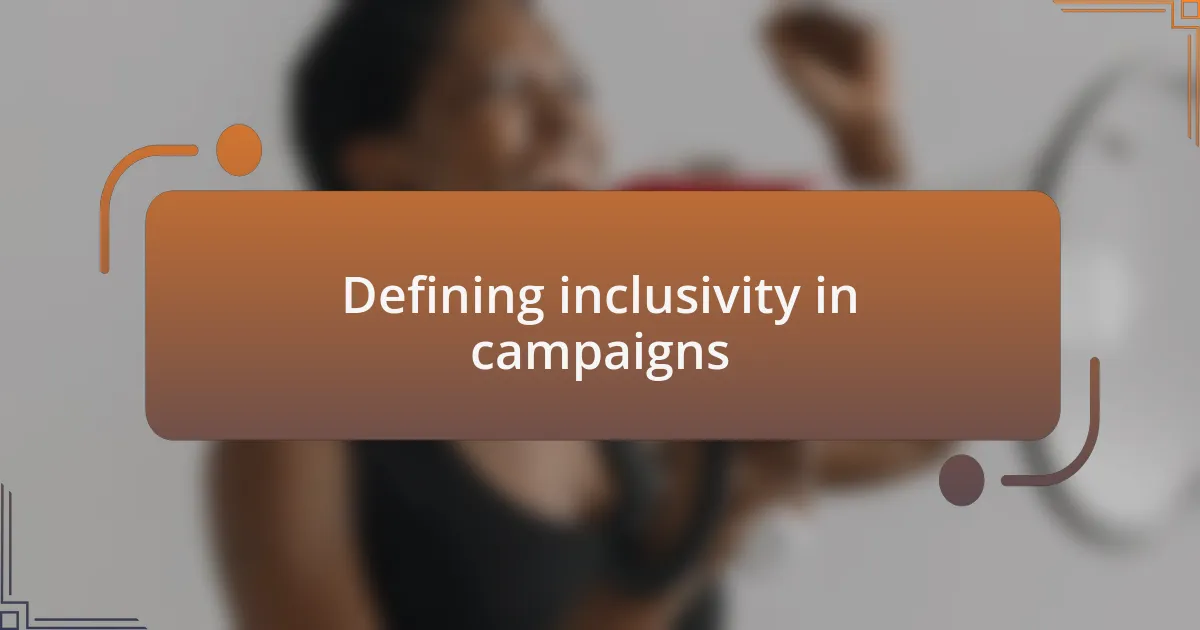
Defining inclusivity in campaigns
Inclusivity in campaigns means actively recognizing and valuing the diverse backgrounds and experiences of all individuals involved. I remember a time during a campaign planning meeting when team members shared their own stories related to pregnancy and choice. Their different perspectives provided profound insights that prompted us to consider how our messaging could resonate with a wider audience. It was a powerful reminder that inclusivity isn’t just a checkbox; it’s about weaving together the tapestry of human experiences.
When I think about inclusivity, I recall an event where voices from various communities—young parents, advocates, and healthcare providers—were invited to share their narratives. Listening to these heartfelt testimonies helped shape our campaign’s design and tone. This practice of incorporating personal stories helps bridge gaps between differing opinions, fostering a sense of belonging. Isn’t it fascinating how shared experiences can unify us, even in divisive conversations?
To me, inclusivity is also about ensuring that no one feels excluded from the dialogue. I once attended a pro-life forum where only a select group was featured in discussions, making others feel invisible. It was an eye-opener, teaching me the importance of creating spaces where everyone, especially those often overlooked, can contribute. How might we transform our campaigns to provide platforms for underrepresented voices? This question drives my ongoing desire to champion inclusivity in all aspects of advocacy.
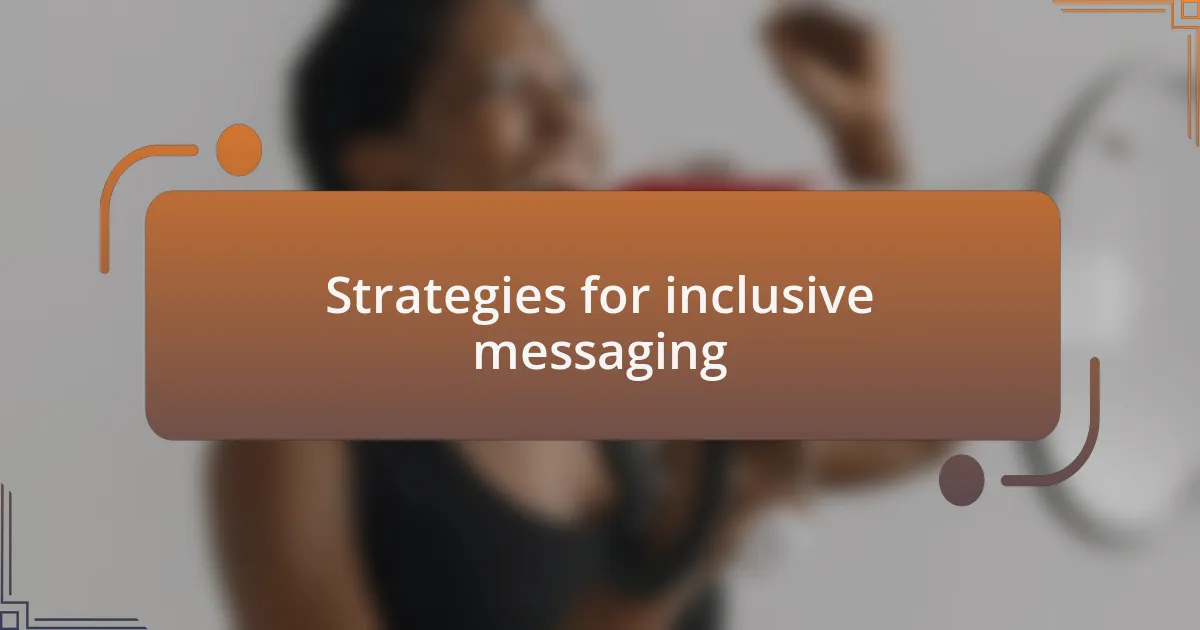
Strategies for inclusive messaging
One effective strategy for inclusive messaging is to actively solicit and incorporate feedback from diverse groups throughout the campaign process. During one campaign, I set aside time for focus groups that included individuals from various backgrounds. I was surprised to learn how different terminologies or visuals resonated uniquely with each group, highlighting the importance of tailoring our message to connect authentically rather than relying on a one-size-fits-all approach.
Ensuring that our materials reflect diversity is another crucial strategy. I recall working on a brochure where I insisted on including images and stories from individuals representing various cultures, ages, and circumstances. Not only did this expand our audience reach, but it also made those who might otherwise feel marginalized see themselves represented. Isn’t it reassuring to think that visibility can empower individuals and foster greater engagement in discussions that matter?
Moreover, using language that encourages dialogue rather than confrontation can significantly alter the reception of our message. I once revised an entire speech to replace divisive language with phrases that invited connection and understanding. The response was overwhelmingly positive; people felt heard rather than attacked. How might our conversations shift if we prioritized empathy over argument? This underlying belief shapes how I approach every aspect of campaign messaging, striving to foster an environment of respect and understanding.

Engaging diverse community voices
One of the best ways to engage diverse community voices is to create open forums where everyone feels safe to express their thoughts. I remember hosting a community discussion where I intentionally invited people from different ethnicities and life experiences. The room was electric with energy, and it was incredible to watch individuals share narratives that profoundly shaped their views on pro-life advocacy. Can you imagine how much richness comes from hearing stories told from different perspectives?
When I think about inclusivity, I often reflect on a specific event where I partnered with local organizations that catered to various community segments. The collaboration allowed us to collect a spectrum of opinions that not only informed our approach but also deepened our connection to the community. This shared space of respect and understanding transformed the atmosphere and encouraged participants to find common ground. How often do we miss the opportunity for connection by overlooking the voices that could broaden our understanding?
I also learned the value of being genuinely curious about others’ experiences. During a campaign, I reached out to individuals who had faced challenges related to our message. Their personal insights often revealed nuances I hadn’t considered before, leading me to adapt our narrative. It was a refreshing reminder that empathy fosters growth, and prioritizing diverse voices opens up a world of understanding. Why do we sometimes shy away from embracing those differences that ultimately strengthen our cause?
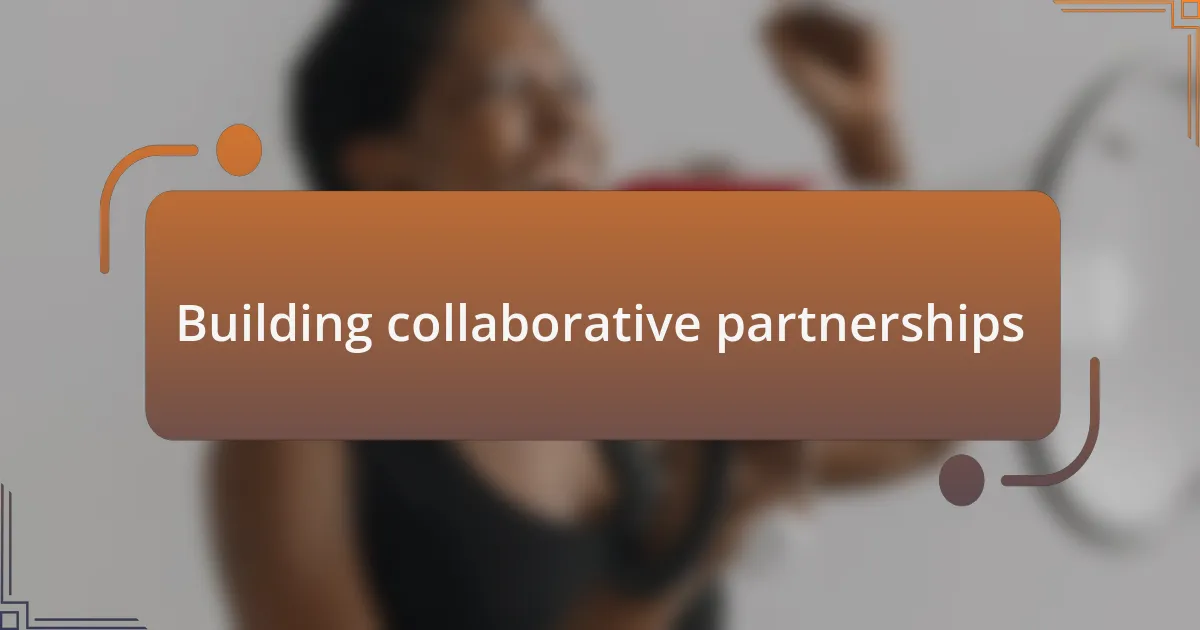
Building collaborative partnerships
Building collaborative partnerships starts with recognizing the unique strengths that different organizations bring to the table. I recall a project where I connected with a local health clinic to discuss our shared vision for the pro-life cause. Working together not only amplified our message but also provided essential resources that enriched our outreach efforts. Isn’t it fascinating how collaboration can significantly enhance the impact of our campaigns?
In one memorable initiative, our coalition worked alongside groups that focused on social justice. I was astonished by how effectively we combined our resources and insights. Through brainstorming sessions, we crafted messages that resonated with diverse audiences, activating not just engagement but genuine connection. What if we all prioritized mutual support over competition? The results could be transformative.
Trust has been a cornerstone of my experiences in partnership-building. I vividly remember a time when I fostered relationships with faith-based organizations, and the level of commitment they showed was inspiring. Their deep-rooted community ties allowed us to reach individuals we might have struggled to connect with otherwise. Have you considered how building trust can open doors to collaborative opportunities that benefit all parties involved?
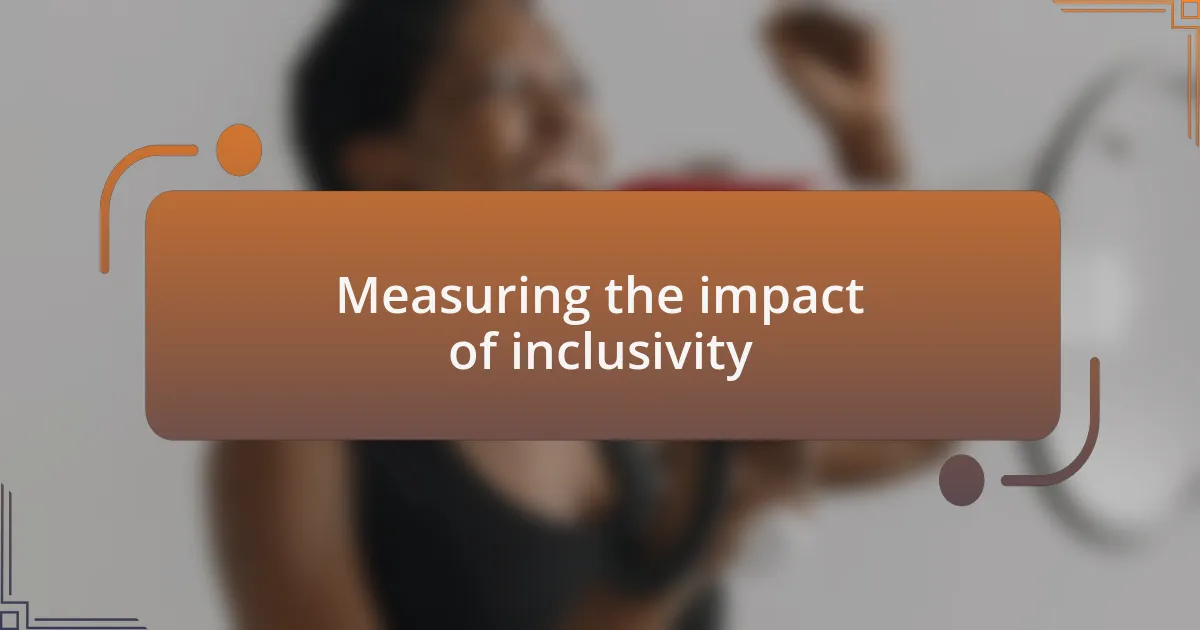
Measuring the impact of inclusivity
Measuring the impact of inclusivity is often more nuanced than it first appears. I remember conducting surveys after a campaign that focused on diverse messaging; the feedback was enlightening. Many participants expressed feeling seen and validated for the first time. Isn’t it incredible how simply acknowledging different perspectives can foster a sense of belonging?
In another initiative, we tracked engagement analytics from various demographic groups. The data revealed a significant uptick in participation from communities we hadn’t previously reached. I often reflect on how this tangible outcome illustrates the power of inclusivity—when individuals feel represented, they are more likely to engage. Have you thought about how your own campaigns could benefit from such inclusive strategies?
However, measuring inclusivity also involves qualitative insights, not just numbers. When I had the opportunity to host focus groups, the personal stories shared left a profound impact on me. Participants spoke about feeling empowered and connected, and their stories reinforced the importance of these seemingly simple inclusive tactics. How often do we take the time to listen to those narratives that truly highlight our movement’s reach and effectiveness?
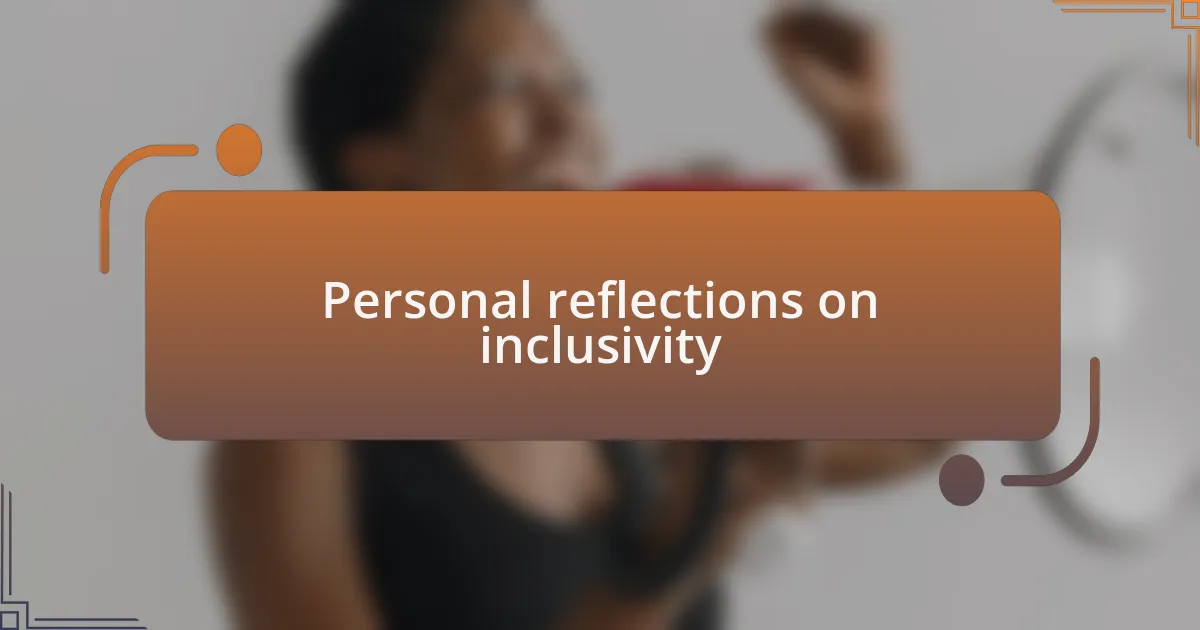
Personal reflections on inclusivity
I often find myself reflecting on a particular campaign where we intentionally included voices from marginalized communities. There was a moment during a strategy meeting when someone shared their unique perspective—one that had been overlooked in prior discussions. The air shifted; I could feel everyone’s engagement deepen, and it struck me how this simple act of listening could spark a more expansive vision for our initiative. Have you considered how much richer your campaigns could be with diverse viewpoints?
One campaign particularly stands out in my memory. We featured stories from individuals who faced real struggles and triumphs surrounding the pro-life narrative. Their honesty was poignant and raw, and I noticed how the audience reacted with empathy. It made me think: are we doing enough to incorporate these authentic stories into our outreach efforts? When we bring narratives to the forefront, we not only educate our audience but also foster a deeper connection that extends beyond mere statistics.
Inclusivity requires consistent self-reflection. I’ve wrestled with my own biases over the years, and there are moments I still falter. For instance, there was a time when I assumed everyone would resonate with a traditional message, but I quickly learned that assumptions can be limiting. When I stepped outside that comfort zone and embraced diverse communications, it opened doors I hadn’t even considered. Have you ever challenged your own assumptions, and how did it reshape your approach?